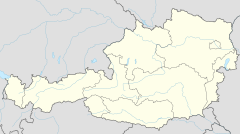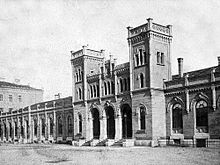
The Austrian Federal Railways, now commonly known as ÖBB, is the national railway company of Austria, and the administrator of Liechtenstein's railways. The ÖBB group is owned entirely by the Republic of Austria, and is divided into several separate businesses that manage the infrastructure and operate passenger and freight services.

Wien Westbahnhof is a major Austrian railway station, the original starting point of the West railway (Westbahn) and a former terminus of international rail services. In 2015, its role changed with the opening of Vienna's new main station and Westbahnhof is now mainly a commuter station and the terminus of private rail operator WESTbahn's intercity service from Salzburg. Locally, Wien Westbahnhof is served by S-Bahn line S50 and U-Bahn lines U3 and U6. Six tram lines converge on Europaplatz in front of the station, although none go into the city centre. There are also buses to the airport.

Vienna has an extensive transport system that includes roads, railways, trams, metro, and buses.

Munich East station is a railway station in Munich, the state capital of Bavaria, Germany. It opened as Haidhausen station in 1871 on the new Munich–Mühldorf and Munich–Rosenheim railway lines. The station is operated by DB Station&Service, a subsidiary of Deutsche Bahn AG. It is classified as a Category 1 station, one of 21 in Germany and two in Munich, the other being München Hauptbahnhof. It is the city's third interregional station besides München Hauptbahnhof in the city centre and München-Pasing in the west.

Wien Hauptbahnhof, Vienna Central Station or Vienna Main Station is the main railway station in Vienna, Austria, located in the Favoriten district. It became fully operational in December 2015, linking major railway lines from the north, east, south and west, and replacing the old Wien Südbahnhof terminus. With 268,000 daily commuters it is Austria's busiest long-distance railway station. Aside from being voted "Austria's most beautiful railway station", it was also second in Consumer Choice Center's ranking of "Top 10 Railway Stations for Passenger Convenience in Europe".

The Magistrale for Europe or Main line for Europe is a Trans-European Transport Networks (TEN-T) project for the creation of a high-speed railway line between Paris and Bratislava, with a branch-off to Budapest. It was listed as TEN project No. 17 (Paris—Bratislava) by the European Commission in 1995, and is already under way.

Railjet is a high-speed rail service in Europe operated by Austrian Federal Railways (ÖBB) and Czech Railways (ČD). Branded as Railjet Express (RJX) for the fastest services and as Railjet (RJ) for services with additional stops, it was introduced in 2008 and operates at speeds of up to 230 km/h (143 mph). Railjet is ÖBB's premier service and operates both domestically within Austria and on international services to adjacent major cities in the Czech Republic, Germany, Switzerland, Italy, Hungary and Slovakia.

Innsbruck Hauptbahnhof is the main railway station in Innsbruck, the capital city of the Austrian federal state of Tyrol. Opened in 1853, the station is a major hub for western and central Austria. In 2019, it was the 8th-busiest station in the country, and the 2nd-busiest outside of Vienna after only Linz Hauptbahnhof, with 315 train movements and 38,500 passengers daily.

Passau Hauptbahnhof is the main railway station at Passau in Bavaria, Germany. Built in 1860, it has eight platforms, of which three are bay platforms and three are through tracks. The ca. 130 m long station building is built in the classic style.

Salzburg Hauptbahnhof is the main railway station in Salzburg, capital of the federal state of Salzburg in Austria. It is the most important station in the agglomeration of Salzburg, and a major transportation hub in western Austria.

Villach Hauptbahnhof is the main railway station in Villach, the second largest city in the Austrian state of Carinthia. It primarily serves as a passenger station and is an important junction within the Austrian Federal Railways (ÖBB) network.

Wels Hauptbahnhof, occasionally Wels Central Station or Wels central station is a railway station at Wels, which is the second largest city in the federal state of Upper Austria, in the north of Austria.

St. Pölten Hauptbahnhof is the main railway station at St. Pölten, which is the capital city of the federal state of Lower Austria, located in the north east of Austria. The station is one of the western endpoints of the Verkehrsverbund Ost-Region.

Klagenfurt Hauptbahnhof is the main railway station in Klagenfurt, capital of the Austrian state of Carinthia. It is an important railway junction in southern Austria.
The Western Railway is a two-track, partly four-track, electrified railway line in Austria that runs from Vienna to Salzburg via St. Pölten and Linz Hauptbahnhof and is one of the major lines of Austria. It was originally opened as the Empress Elisabeth Railway in 1858 (Vienna–Linz). The line is owned and operated by Austrian Federal Railways (ÖBB).

WESTbahn Management GmbH is an open access railway company operating express train services on Austria's Western Railway since 11 December 2011. The French railway company SNCF has a 17.4 percent stake in WESTbahn.

The Wels–Passau railway—also called the Passauer Bahn in German—is a two-track, electrified main line railway mainly in Austria, which was originally owned and operated by the k.k. privilegierte Kaiserin Elisabeth-Bahn company. It runs from Wels in Upper Austria to Passau in Bavaria and is part of the core network of the Austrian Federal Railways.

Trams in Linz is a network of tramways forming the backbone of the urban public transport system in Linz, which is the capital city of the federal state of Upper Austria in Austria.

Vienna Airport is a railway station serving Vienna International Airport in Schwechat, Lower Austria, Austria. The train services are operated by ÖBB and Deutsche Bahn.

The Budweis-Linz-Gmunden Horse-Drawn Railway was the second public railway line to be opened in mainland Europe. It opened in stages between 1827 and 1836, and principally served the transport of salt from the Upper Austrian Salzkammergut to Bohemia.

























